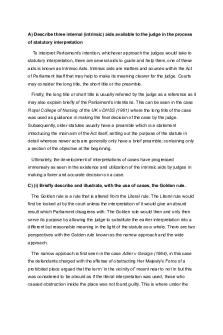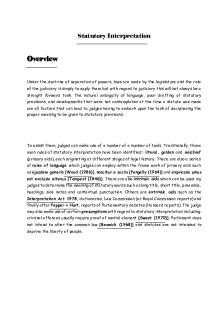Statutory Interpretation Notes PDF

| Title | Statutory Interpretation Notes |
|---|---|
| Course | Constitutional Law I and II |
| Institution | University of Leeds |
| Pages | 4 |
| File Size | 65.3 KB |
| File Type | |
| Total Downloads | 104 |
| Total Views | 190 |
Summary
statutory interpretation notes...
Description
Statutory Interpretation Notes Statutory Interpretation - definition -> The process whereby judges interpret relevant Acts of Parliament in order to decide a particular case. Why is statutory interpretation needed? -> ● There may be a broad term used in the statute that needs clarification e.g. the word 'type' was used in the Dangerous Dogs Act 1991 rather than the more usual word 'breed'. ● Ambiguity; a word in a statute may have more than one meaning ● A drafting error; Parliamentary Draughtsman are not perfect and mistakes do sometimes happen e.g. in the OAPA 1861 the words 'cause' and 'inflict' are both used to mean the same thing. ● New developments; new technology could mean that an old Act of Parliament does not cover present day situations e.g. RCN v DHSS [1981]. The Literal Rule -> Here the courts will give the words in the statute their ordinary, literal meaning, even if doing that will lead to a less than sensible result. Lord Esher said in 1892 that 'the court has nothing to do with whether the legislature has committed an absurdity'. This rule should be used as the starting point for interpreting any legislation, particularly if it is clearly worded. Examples of the Literal Rule -> ● Whiteley v Chappell - D was charged with 'impersonating someone entitled to vote'. D was actually impersonating a dead person who was not technically entitled to vote; HELD not guilty. ● LNER v Berriman - Man killed whilst oiling railway lines and widow not entitled to compensation as relevant safety regulations stated a lookout only needed to be posted when 're-laying or repairing tracks'. The Golden Rule -> A modification of the Literal Rule that is designed to avoid an interpretation that is absurd. Two approaches: ● Narrow approach is where there is a word or phrase that could have more than one meaning. Court will decide which meaning to use. ● Broad approach is where the wording of the statute is clear, but following these would lead to a morally repugnant result, so the court will use the Golden Rule to modify the words of the statute to avoid the problem. Examples of the Golden Rule -> ● Narrow Approach ○ Adler v George - court had to consider the meaning of the term 'in the vicinity of' under the Official Secrets Act 1920. ● Broad Approach
○
Re Sigsworth - in this case a son murdered his mother and under the provisions of the Administration of Justice Act 1925 would have inherited her estate. The courts used the golden rule to prevent this morally repugnant outcome.
The Mischief Rule -> The oldest rule, defined in Heydon's case (1584). Under this rule the courts should look to see what the law was before the Act was passed in order to discover what gap or 'mischief' the Act was intended to cover. The court should then interpret the Act in such a way that the gap is covered. This is clearly a very different approach to the Literal Rule. Examples of the Mischief Rule -> ● Smith v Hughes - Under s1(1) of the Street Offences Act 1959 it was an offence 'for a common prostitute to loiter or solicit in a street or public place' The DDs were in fact in a private dwelling, however the courts used the mischief rule as they were still soliciting men who were walking on the street. ● RCN v DHSS - This case considered whether nurses could be considered to be registered medical practitioners under the provisions of the Abortion Act 1967 for the purposes of carrying out abortions. Courts agreed they could, as the 'mischief' Parliament intended to eradicate was back street abortions by unqualified people. The Purposive Approach -> This approach goes beyond the Mischief Rule in that here the judges decide what they believe Parliament meant to achieve through the Act. ● This approach became more widespread in the UK following our joining of the EU as their law is written in broader terms and so needs an element of interpretation. In every case involving EU law, it is likely that the Purposive Approach would b used to decide the case. Examples of the Purposive Approach -> ● R v Registrar General, ex parte Smith - Here the courts refused to allow a convicted murderer access to the records of his birth mother (he had been adopted) even though he had met the relevant criteria laid down under s51 of the Adoption Act 1976. ● Quintaville case - Courts extended the definition of 'embryo' under the Human Fertilisation and Embryology Act 1990 due to changes in medical science. Intrinsic (Internal) Aids to Interpretation -> These are internal to the statute itself and include: ● The Short and Long Title ● Preamble ● Interpretation section e.g. s4(1) of the Theft Act defines the meaning of 'property' under this offence. ● Schedules attached to the Act Extrinsic (External) Aids to Interpretation -> These are aids to interpretation that judges may use that are outside of the relevant statute: ● Hansard (following decision in Pepper v Hart). This can only be used to help determine the purpose of the statute as set out by the sponsor of the bill.
● ● ●
Dictionaries of the time (as used in Cheeseman v DPP to define 'passenger') Previous Acts of Parliament on the same topic (as used in Cheeseman to define 'street') Law Commission Reports that may have led to the creation of that Act of Parliament
The Effect of EU Law on Interpretation -> ● Purposive approach is the one most preferred by most European Countries when interpreting EU law. It is also the approach used by the ECJ when interpreting EU law. ● As judges in the UK have been using the purposive approach for almost 40 years then some might adopt that approach in other cases. ● Following the Marleasing case judges in the UK have to interpret national law in light of EU law. The effect of the Human Rights Act 1998 on Interpretation -> s3 of the HRA states that legislation must be read and given effect in a way which is compatible with rights in the ECHR e.g. Mendoza v Ghaidan where the courts had to interpret the provisions of the Rent Act 1977 to include same sex couples to avoid discrimination occurring. Evaluation of the Literal Rule -> ● Advantages ○ Respects Parliamentary Sovereignty and judicial role under the separation of powers ○ Prevents unelected judges from creating law ○ Leads to greater certainty as the law will be interpreted exactly as it is written ● Disadvantages ○ Assumes every act of Parliament will be perfectly drafted e.g. Whitely v Chappell ○ Can lead to 'manifest absurdities' or unjust decisions as in Berriman. ○ Professor Michael Zander described the Literal rule as being mechanical and divorced from the realities of the use of language. Evaluation of the Golden Rule -> ● Advantages ○ Respect parliamentary sovereignty except in limited situations ○ Provides an 'escape route' against morally repugnant outcomes in cases ○ -Allows the judge to determine the most sensible use of an unclear term e.g. R v Allen ● Disadvantages ○ Professor Zander described it as a 'feeble' parachute, as it can only be used in very limited cases. Evaluation of the Mischief Rule -> ● Advantages ○ Promotes the purpose of the law and makes sure that the gaps in the law are filled e.g. Smith v Hughes. ○ More likely to produce a 'just' result.
○
●
Law Commission argued back in 1969 that this rule should be the only one used in statutory interpretation. Disadvantages ○ Risk of judicial law making. Decision in RCN v DHSS was 3:2 and two judges believed the court would be going too far in their role to decide that nurses could perform abortions. ○ Leads to uncertainty in the law, making it difficult for lawyers to advise clients. ○ Retrospective effect which is against the rule of law e.g. Smith v Hughes. ○ Not as wide as a purposive approach as only used to fill 'gaps' left by Parliament.
Evaluation of the Purposive Approach -> ● Advantages ○ Leads to justice in individual cases and avoids absurd or even dangerous outcomes e.g. ex parte Smith and R v Rogers. ○ Allows for changes in society and technology e.g. Quintaville. ○ Parliament does not have to spend a lot of time on small, minor amendments to statutes. ● Disadvantages ○ How are judges able to assess Parliament's intentions accurately? Hansard can be used but information contained is limited. ○ Leads to judicial law making which contravenes the separation of powers. ○ Leads to uncertainty in the law as it is impossible to know when a judge might use this approach rather than that literal rule....
Similar Free PDFs

Statutory interpretation notes
- 2 Pages

Statutory Interpretation
- 6 Pages

Statutory Interpretation
- 6 Pages

Statutory Interpretation Notes
- 9 Pages

Statutory Interpretation Notes
- 4 Pages

Statutory Interpretation
- 3 Pages

Statutory Interpretation
- 5 Pages

Statutory Interpretation
- 11 Pages

Statutory Interpretation
- 6 Pages

Statutory Interpretation 70102
- 5 Pages

Statutory Interpretation in Malaysia
- 12 Pages
Popular Institutions
- Tinajero National High School - Annex
- Politeknik Caltex Riau
- Yokohama City University
- SGT University
- University of Al-Qadisiyah
- Divine Word College of Vigan
- Techniek College Rotterdam
- Universidade de Santiago
- Universiti Teknologi MARA Cawangan Johor Kampus Pasir Gudang
- Poltekkes Kemenkes Yogyakarta
- Baguio City National High School
- Colegio san marcos
- preparatoria uno
- Centro de Bachillerato Tecnológico Industrial y de Servicios No. 107
- Dalian Maritime University
- Quang Trung Secondary School
- Colegio Tecnológico en Informática
- Corporación Regional de Educación Superior
- Grupo CEDVA
- Dar Al Uloom University
- Centro de Estudios Preuniversitarios de la Universidad Nacional de Ingeniería
- 上智大学
- Aakash International School, Nuna Majara
- San Felipe Neri Catholic School
- Kang Chiao International School - New Taipei City
- Misamis Occidental National High School
- Institución Educativa Escuela Normal Juan Ladrilleros
- Kolehiyo ng Pantukan
- Batanes State College
- Instituto Continental
- Sekolah Menengah Kejuruan Kesehatan Kaltara (Tarakan)
- Colegio de La Inmaculada Concepcion - Cebu




